The Isolated Image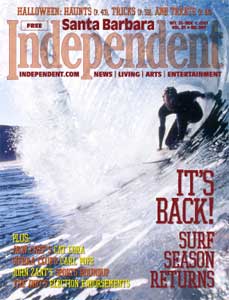
Recent works by Chris Messner
Neuvié Contemporary Furniture
October 4 – December 3, 2007
Review by Stephen T. Vessels
Chris Messner’s photographs translate details into found art. They capture the grace and mystery in architectural features and natural phenomena by isolating them from their context and treating them as elements of composition. It is easy to view them as mere decorative objects, an impression unavoidably supported by their display in a retail setting. A more thoughtful examination raises questions, the elusive sense that something is being said. The photos reflect an almost prayerful awe of the daunting grandeur of the human environment.
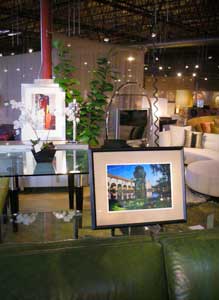 By his own admission, Messner feels his work expresses things he finds difficult to put into words. He is a self-taught photographer, exploring, at the age of forty-six, a way of seeing he says he’s had since he was a child. He credits Paul Mills, the former director of The Santa Barbara Museum of Art, with encouraging him to take his photography more seriously. For the last four years he has done so, phasing out his work as a landscape designer.
By his own admission, Messner feels his work expresses things he finds difficult to put into words. He is a self-taught photographer, exploring, at the age of forty-six, a way of seeing he says he’s had since he was a child. He credits Paul Mills, the former director of The Santa Barbara Museum of Art, with encouraging him to take his photography more seriously. For the last four years he has done so, phasing out his work as a landscape designer.
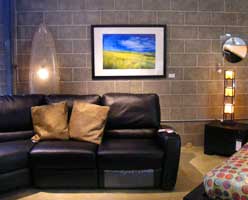 He shoots 35mm slides and does not manipulate the images digitally. It is plain that he has a strong graphic instinct. Everything in his images results from visual composition. Much of the current exhibit is taken up with architectural photographs Messner took in Japan, Fort Worth, and Los Angeles. Among these it is often impossible to tell where the individual pictures were shot without consulting the information cards. The jumbled facets of the multi-angular exterior of a “Downtown Kyoto Mall” resemble a cubistic sculpture. Intersecting office buildings in “Fort Worth” could have been taken down the street from vertically parallel structures of skyscrapers in “Little Tokyo,” shot in downtown L.A.
He shoots 35mm slides and does not manipulate the images digitally. It is plain that he has a strong graphic instinct. Everything in his images results from visual composition. Much of the current exhibit is taken up with architectural photographs Messner took in Japan, Fort Worth, and Los Angeles. Among these it is often impossible to tell where the individual pictures were shot without consulting the information cards. The jumbled facets of the multi-angular exterior of a “Downtown Kyoto Mall” resemble a cubistic sculpture. Intersecting office buildings in “Fort Worth” could have been taken down the street from vertically parallel structures of skyscrapers in “Little Tokyo,” shot in downtown L.A.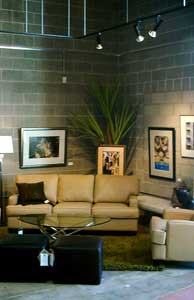 The centerpiece of the exhibit, entitled “Urban Creation,” juxtaposes a sculptural detail embellishing of the façade of the Bass Brothers’ building in Fort Worth – the stylized rendering of a generic city skyline, rising, like a bouquet of skyscrapers, above the marquee – with the upward pointing hand, just visible to the marquee’s right, of a winged figure adorning the entrance of the otherwise hidden Fort Worth Opera House. This image could serve as an artistic statement, illuming much that one finds in the exhibit as a whole.
The centerpiece of the exhibit, entitled “Urban Creation,” juxtaposes a sculptural detail embellishing of the façade of the Bass Brothers’ building in Fort Worth – the stylized rendering of a generic city skyline, rising, like a bouquet of skyscrapers, above the marquee – with the upward pointing hand, just visible to the marquee’s right, of a winged figure adorning the entrance of the otherwise hidden Fort Worth Opera House. This image could serve as an artistic statement, illuming much that one finds in the exhibit as a whole.
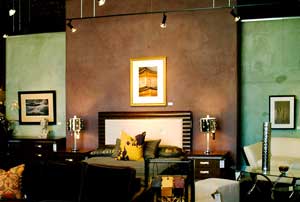 The questions, like angels and devils, are in the details in the details. A “Blue Umbrella” hangs upside down from the balcony of an apartment building in Mito, Japan. A blue lamp post bends low beneath a giant, red-and-black, vertical array of Japanese billboard characters in “Downtown Tokyo Sign,” like a burdened individual searching for answers or support.
The questions, like angels and devils, are in the details in the details. A “Blue Umbrella” hangs upside down from the balcony of an apartment building in Mito, Japan. A blue lamp post bends low beneath a giant, red-and-black, vertical array of Japanese billboard characters in “Downtown Tokyo Sign,” like a burdened individual searching for answers or support. 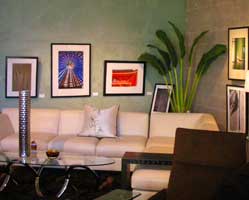 Perhaps the beginnings of answers are found in the less prominent images of natural phenomena, the fractal-like confusion of black branches limned with snow in “La Cumbre Peak Snow,” the ineffectual boundary of a barbed-wire fence pursuing the contours of wheat fields beneath an overwhelming sky in “Ranch Rail Skies Forever.” Or perhaps the clearest answer lies the respect for found beauty quietly evident throughout the exhibit.
Perhaps the beginnings of answers are found in the less prominent images of natural phenomena, the fractal-like confusion of black branches limned with snow in “La Cumbre Peak Snow,” the ineffectual boundary of a barbed-wire fence pursuing the contours of wheat fields beneath an overwhelming sky in “Ranch Rail Skies Forever.” Or perhaps the clearest answer lies the respect for found beauty quietly evident throughout the exhibit.
